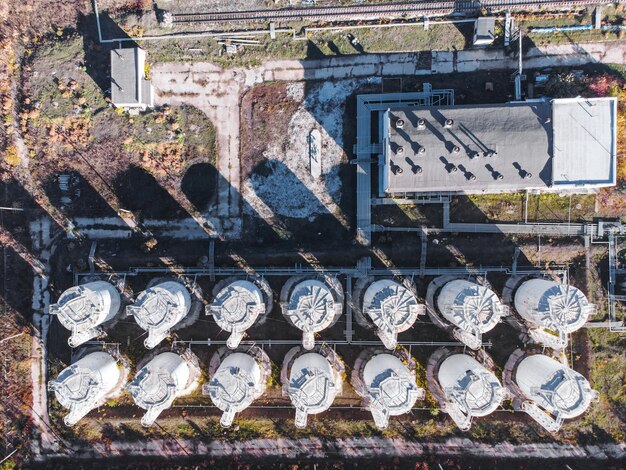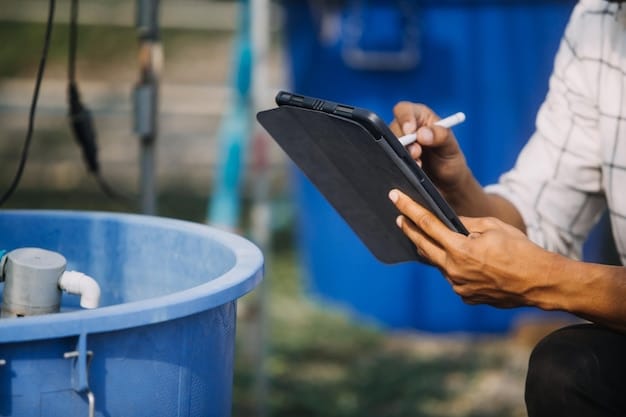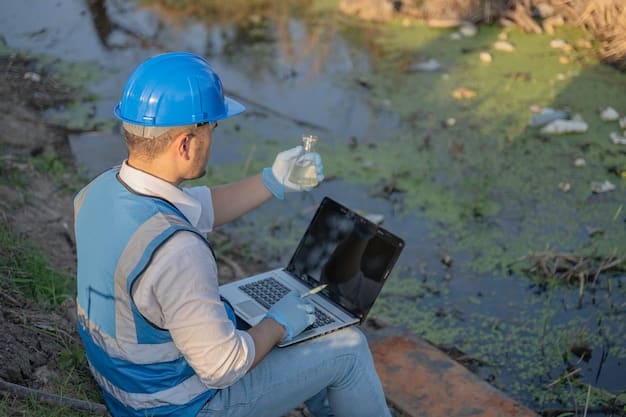Latest US Water Purification Innovations: Solving Scarcity

The latest innovations in US water purification technology are addressing water scarcity and improving access to clean water through advanced filtration systems, smart monitoring, and sustainable practices.
The Latest Innovations in US Water Purification Technology: Addressing Scarcity and Improving Access to Clean Water are revolutionizing how we obtain and manage this essential resource. From drought-stricken regions to underserved communities, innovative solutions are emerging to ensure every American has access to safe, clean drinking water.
The Growing Need for Advanced Water Purification
Water scarcity is an escalating concern across the United States, driven by climate change, population growth, and aging infrastructure. As traditional water sources become strained, the need for advanced water purification technologies becomes increasingly critical. These technologies not only augment existing supplies but also ensure water quality, addressing both scarcity and health concerns.
The Southwest, in particular, faces acute water shortages. However, even regions with historically abundant water resources are experiencing the impacts of droughts and contamination. This widespread challenge highlights the importance of adopting diverse and innovative water management strategies. Investing in research, development, and implementation of these technologies is crucial for a secure and sustainable water future for all Americans.
Key Challenges in US Water Management
Several factors exacerbate water scarcity and quality issues:
- Aging Infrastructure: Many US cities rely on outdated water distribution systems, leading to leaks, contamination, and inefficient water usage.
- Climate Change: Prolonged droughts, increased evaporation, and altered precipitation patterns intensify water scarcity in vulnerable regions.
- Population Growth: Rapid urbanization and population growth in already water-stressed areas put further strain on available water resources.
- Contamination: Industrial discharge, agricultural runoff, and emerging contaminants like PFAS pose significant threats to water quality.
These challenges necessitate a comprehensive approach that combines technological advancements, policy reforms, and community engagement to ensure water security.

Advanced Filtration Systems
Advanced filtration systems are at the forefront of water purification innovations. These technologies are designed to remove a wide range of contaminants, from microscopic bacteria to industrial chemicals. They offer a more effective and efficient way to purify water compared to traditional methods, ensuring a higher quality of potable water.
These systems are rapidly being deployed in municipal water treatment plants, industrial facilities, and even residential settings to combat waterborne diseases and chemical pollutants effectively. Continuous advancements in materials and engineering are making these systems more affordable, energy-efficient, and versatile, contributing significantly to water sustainability efforts.
Membrane Filtration Technologies
Membrane filtration technologies, such as reverse osmosis (RO) and ultrafiltration (UF), are among the most promising in addressing water quality concerns. Here’s a brief overview:
- Reverse Osmosis (RO): RO uses pressure to force water through a semi-permeable membrane, removing salts, minerals, and other impurities. It is widely used in desalination plants and for purifying drinking water.
- Ultrafiltration (UF): UF uses a similar process but removes larger particles, such as bacteria, viruses, and colloids. It is commonly used as a pre-treatment for RO or as a standalone filtration method.
- Nanofiltration (NF): NF lies between RO and UF in terms of pore size and contaminant removal. It is effective in removing hardness, heavy metals, and some organic matter.
The use of these technologies allows for the treatment of diverse water sources, including wastewater and brackish water, reducing the reliance on increasingly scarce freshwater resources.
Smart Water Monitoring Systems
Smart water monitoring systems are vital for optimizing water resource management and detecting potential contamination issues. These systems use sensors, data analytics, and communication technologies to provide real-time insights into water quality, distribution, and usage.
By continuously monitoring various parameters, such as pH levels, turbidity, and chemical concentrations, these systems can quickly identify anomalies and trigger appropriate responses. This proactive approach helps prevent waterborne diseases, reduce water losses due to leaks, and improve overall water system efficiency.

Benefits of Smart Monitoring
Smart monitoring systems provide numerous benefits:
- Early Detection of Contamination: Real-time monitoring allows for the rapid detection of pollutants, enabling swift action to prevent widespread contamination.
- Leak Detection and Prevention: Sensors can identify leaks in water distribution networks, reducing water losses and preventing infrastructure damage.
- Optimized Water Usage: Data analytics can provide insights into water consumption patterns, helping to optimize water distribution and promote conservation.
- Improved Water Quality: Continuous monitoring ensures that water meets regulatory standards, safeguarding public health.
The integration of smart monitoring technologies into water management practices is essential for creating resilient and sustainable water systems.
Sustainable Desalination Technologies
Desalination, the process of removing salt and minerals from seawater or brackish water, offers a potentially limitless source of freshwater. However, traditional desalination methods are energy-intensive and can have negative environmental impacts. Sustainable desalination technologies aim to address these limitations.
Innovations in energy recovery, membrane technology, and renewable energy integration are making desalination more environmentally sustainable and economically viable. These advancements are crucial for expanding the use of desalination as a viable water source, particularly in water-scarce coastal regions.
Recent Advances in Desalination
Several techniques are being developed to enhance the sustainability of desalination:
- Renewable Energy Integration: Using solar, wind, or geothermal energy to power desalination plants can significantly reduce greenhouse gas emissions and operating costs.
- Advanced Membrane Materials: New membrane materials with improved permeability and selectivity can reduce energy consumption and enhance water recovery.
- Electrodialysis Reversal (EDR): EDR uses electric fields to separate salts from water, offering a more energy-efficient alternative to RO in some applications.
By embracing these advancements, desalination can become a key component of a sustainable water management strategy.
Nature-Based Water Purification Solutions
Nature-based solutions (NBS) work with natural processes to purify and manage water resources. These solutions include constructed wetlands, green infrastructure, and aquifer recharge systems.
NBS offers a cost-effective and environmentally friendly approach to water purification and flood control, improving ecosystem health and enhancing community resilience. These strategies focus on restoring and mimicking natural hydrologic cycles, providing multiple benefits beyond water purification.
Examples of Nature-Based Solutions
Here are some examples of how NBS is being implemented:
- Constructed Wetlands: These artificial wetlands use plants, soil, and microorganisms to remove pollutants from wastewater and stormwater runoff.
- Green Infrastructure: Green roofs, rain gardens, and permeable pavements reduce stormwater runoff, filter pollutants, and recharge groundwater.
- Aquifer Recharge: Injecting treated water into underground aquifers replenishes groundwater supplies and reduces saltwater intrusion in coastal areas.
Incorporating NBS into water management strategies can enhance both water quality and quantity while also supporting biodiversity and ecosystem services.
The Role of Policy and Investment
Policy and investment play a crucial role in driving the adoption and deployment of innovative water purification technologies. Government regulations, incentives, and funding programs can significantly influence the pace and direction of technological development and deployment.
By creating a supportive regulatory environment, promoting research and innovation, and investing in infrastructure improvements, policymakers can accelerate the transition toward more sustainable and resilient water systems. Public-private partnerships can also leverage expertise and resources to address complex water challenges effectively.
Key Policy Recommendations
To foster innovation and adoption of advanced water purification technologies, the following policy recommendations are essential:
- Incentivize Innovation: Provide grants, tax credits, and other incentives for research and development of new water purification technologies.
- Establish Clear Regulations: Develop clear and consistent regulations for water quality and treatment to ensure public health and environmental protection.
- Invest in Infrastructure: Allocate funding for upgrades to aging water infrastructure, including the deployment of advanced filtration and monitoring systems.
A comprehensive and forward-thinking policy framework is necessary to guide the development and implementation of sustainable water solutions.
| Key Point | Brief Description |
|---|---|
| 💧 Advanced Filtration | Uses membranes like RO and UF to remove contaminants effectively. |
| 📊 Smart Monitoring | Real-time data helps detect contamination and optimize water use. |
| ☀️ Sustainable Desalination | Employs renewable energy and advanced membranes for efficiency. |
| 🌿 Nature-Based Solutions | Utilizes wetlands and green infrastructure for natural purification. |
Frequently Asked Questions
▼
Water scarcity in the US stems from climate change, population growth, aging infrastructure, and contamination of water sources, all contributing to reduced availability.
▼
Reverse osmosis removes salts, minerals, and impurities from water by forcing it through a semi-permeable membrane, resulting in highly purified water.
▼
Smart monitoring systems use sensors to continuously track water quality, detect leaks, and optimize water usage, ensuring efficient resource management.
▼
Sustainable desalination technologies reduce the environmental impact of producing freshwater from seawater by using renewable energy and advanced membranes.
▼
Nature-based solutions like wetlands and green infrastructure naturally filter pollutants from water, enhancing ecosystem health and providing cost-effective water management.
Conclusion
The latest innovations in US water purification technology offer promising solutions to address water scarcity and improve access to clean water. From advanced filtration systems to smart monitoring and sustainable practices, these technologies are paving the way for a more secure and sustainable water future for all Americans. By embracing these advancements and investing in supportive policies, the US can effectively tackle the challenges of water scarcity and ensure that clean water resources are available for generations to come.





